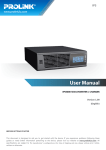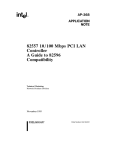Download 26KB PDF
Transcript
6/03-F5 RFDS 3 MULTIPURPOSE DETECTION SET USER MANUAL Content: I. Detection of RF field (RFD-5) 1. Without external probe 2. With external probe II. Detection of RF pulse devices (RFD-5) III. Permanent protection (RFD-5) IV. RFD-5 Common notes V. Principle of wire localization (WHG + RFD-5) VI. Tracing the cables (WHG + RFD-5) VII. Localization of cut wire in a cable (WHG + RFD-5) VIII. Localization of illegal (microphone) cables (WHG + RFD-5) IX. WHG common notes (batteries, antennas) X. Principle of LTA-2 XI. Telephone line checking (LTA-2 + RFD-5) 1. Audio 2. LF - line transmitters XII. Other lines and suspected cables checking (LTA-2 + RFD-5) I. Detection of RF field - sweeping (RFD-5) To detect the RF field the RFD-5 can be used without or with external probe. 1. Without external probe -Switch ON -AUDIO ON enables localization variable tone. Stronger signal = higher tone -Adjust MEASURE mode -Connect earphone to hear what type of signal is detected -UP/DOWN are regulating audio gain -Pull out the telescope antenna -Walk around the swept area. Move the RFD-5 to inspect all objects in the room. Some RF bugs have so low power that can be detected within centimeters only. In places with a strong RF background (TV, FM, broadcast, mobile cells etc.) the display is still indicating more than 70. In such places the sweeping has to be done more carefully. -Listen to the demodulated signal in the earphone. The sound is normally informing about background signals. Commonly used FM unscrambled bugs usually have detectable AM modulation. The sounds from the checked room is then heard in the earphone. Unfortunately there is a number of bugging systems which are only increasing the RF level, but the modulation can not be recognized. Every sharp increase of RF field in the room must be considered like a dangerous and the reason and the spot where the signal is originated must be found. Watch the LCD indicator to find the strongest signal. Check if such dangerous signal is also in next rooms or out of the object. 2. With the external probe -Connect the 3.5 mm plug to EXT. PROBE input. -The plug is disconnecting the internal detector. The RFD-5 telescope antenna can be pushed down. -Sweep carefully all places unattainable without an external probe. -To increase quality of sweeping inspect the whole room again. The external probe has different frequency response. To use both methods (without and with external probe) gives always better results = higher security. II. Detection of RF pulse devices (RFD-5) If during a sweeping some short pulses are detected: -Switch RFD-5 to PROTECT mode -If an RF burst appears its highest level is written to the alarm memory. -The highest level is displayed in PEAK section of LCD -Change place of the RFD-5 in the room to find a spot where the pulses are the strongest. III. Permanent protection (RFD-5) The RFD-5 can also be used for permanent protection of a small room. This can work only if the local background is not strong and its level is constant. -Select PROTECT mode -The RFD-5 automatically stores the background level -Any higher RF level than originally stored background is detected, displayed and written to memory. -If the AUDIO is ON the user is informed about each increase of the RF field by a beep. -In permanent protection application is recommended to use a NiCd accumulator and an external 12V power supply IV. Common notes for RFD-5 -Telescope antenna or external probe can be used in all modes -RF level is indicated in interval 000 to 250 -LOW BATT indication and low sound in the beeper are warning that the battery must be replaced. -Battery is behind the bottom lid -Be careful and avoid static electric discharges to the telescope antenna or to the top of external probe V. Principle of wire localization (WHG + RFD-5) This system was developed for localization of hidden cables. The WHG is a special generator which is producing special wide band RF spectrum modulated by an audio tone. The spectrum is transmitted by wires or cables connected to central pin of the WHG output connector. This signal can be detected by RFD-5 along the connected cable and along the whole connected network. Because the connected cable or connected network is radiating the RF spectrum like a transmit antenna, the wires near this TX antenna are acting like a receive (RX) antenna. Along the RX antenna is weaker, but also detectable increase of the radiated RF signal. VI. Tracing the cables (WHG + RFD-5) -Connect the central pin of WHG to the known end of the cable (any wire in low voltage networks, zero potential in mains network) -For connection use the 1 m wire -The WHG box should be situated on the as conductive as possible surface (floor, heating, concrete etc.) to have the highest possible grounding capacity -The WHG should be placed and connected in the neighboring room. If the WHG is close to the detector RFD-5, the RFD-5 is more detecting the direct "body radiation" of WHG than the radiation of the traced wire -Switch ON the WHG and the RFD-5 detects strong increase along the connected cable. The most sensitive and accurate is the top of the telescope antenna or the top of external probe -Always use the earphone to be sure that tracing the right WHG signal (tone approx. 1 kHz). If the RFD-5 is overloaded by the WHG signal reduce VOLUME and shorten the telescope antenna VII. Localization of cut wire in a cable (WHG + RFD-5) -The procedure is the same like in VI., but connect the WHG output pin to the cut (defected) wire -Carefully trace the cable. In the defected spot is remarkable and sharp decrease of the WHG signal -Localization of a cut wire perfectly works with mains cables. Shielded communication cables are problem, the response is not detectable if the shielding is not damaged VIII. Localization of illegal (microphone) cable (WHG + RFD-5) The principle of this function is that around the RX antenna is also detectable increase of RF field. -Switch ON and connect the WHG in the neighboring room like it was done in point VI. -The mains network is usually the best for radiating of the WHG RF signal -In the swept room must be detected a strong increase of the WHG signal along the mains cables trace and near the mains outlets -Sweep carefully the whole space, each centimeter, by the RFD-5. Focus attention to suspected things like moldings, fillets, wood panels, carpets and other traces where a hidden illegal microphone cable can be installed. The increase of WHG signal in RFD-5 is weak and depends how deep is the hidden cable and also on its trace - how far is from the radiating mains network -In an object without any already installed electric network it is possible to use for transmitting the WHG signal the 3 m antenna. Install WHG and its 3 m antenna as far as possible from the swept area and in the place where the illegal (microphone) cable could be leaving the object. Extending the 3 m antenna to 6 to 20 m can give better results, it depends on local condition. IX. WHG common notes If the battery voltage drops bellow 7V the LED does not light, but the WHG is still working. To replace 2 pcs of IEC 3R12 (4.5 V flat type) batteries unscrew the bottom lid. Normally the WHG is connected to the transmitting network by 1 m wire. The 3m wire can be used like an antenna (see VIII.). Output of WHG is separated by the capacitor, isolation voltage is 500V. Ground of WHG is usually not connected, but the WHG should be put on grounded surface like floor, concrete, heating etc. to have the highest possible capacity to the object ground. X. Principle of the LTA-2 The LTA-2 is a line adapter, connected to RFD-5 EXT. PROBE input. Inside LTA-2 are separation capacitors, filters and low frequency AM and FM detector. In all applications the green plug is ground (common) and the white plug is an active wire. XI. Telephone line checking (LTA-2 + RFD-5) 1. Audio -Connect LTA-2 to EXT. PROBE input. Switch RFD-5 ON, MEASURE mode, AUDIO on the RFD-5 OFF. Connect earphone to RFD-5. -Switch LTA-2 to AUDIO mode. The kHz switch has no function in AUDIO mode -Successively connect green and white pins to all pairs leaving the swept room and listen if any room sound is not heard in the earphone. This procedure is checking if any telephone device is not modified (microphone and earphone of telephone devices must be disconnected). Check also other wires leaving the room to be sure that any illegal microphone is not connected to them. -Try other combinations between wires -Try each wire against common ground (if the ground is available) -Some secretary telephone systems are not disconnecting microphone or earphone and the audio signal is permanently leaving the VIP room. In such case organization measures must be taken to avoid unauthorized excess to the telephone cables. 2. Low frequency - LF line transmitters -Adjust RFD-5 like in point XI.1) -Switch LTA-2 to DETECTOR mode -Successively connect all pairs and wires combinations like in point 1) -For each pair switch the kHz to all three positions and listen its response in the earphone. Watch also the display. Usually at lower frequencies (20-50 kHz) is more noise caused by mains harmonics. Near AM LW and MW broadcast transmitters the radio program can be heard in the sequence 90-160 kHz. 90-160 kHz frequency segment is extended (with lower sensitivity) to 5 MHz, because there are some line bugs using frequencies about 2 MHz. -Small bugs usually have FM modulation which is heard in the earphone. But there are also digital devices which are just causing different noise in the earphone and also the increase of LED display. Localization of a digital line device is also possible, but it needs to measure from more spots and to find the strongest signal. -Practical note: If a pair is connected to LTA-2 it is useful to successively check all modes: AUDIO - DETECTOR 20/50 - DETECTOR 90/160 - DETECTOR 50/90 kHz. XII. Other lines and suspected cables checking (LTA-2 + RFD-5) For the microphone or LF eavesdropping other lines can be used (mains, security system, intercom etc.). During sweeping all cables leaving the object should be checked. The checking procedure is the same like in point XI. IMPORTANT: The operator must be very careful and well instructed to avoid any dangerous. The green pin of LTA-2 should always be connected first to zero (ground) potential and the white pin later to higher potential wire. The isolation between box of RFD-5 to the green pin is a capacitor 100nF 275V AC. The active white pin is separated by a capacitor 1nF 440V AC.




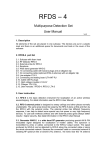
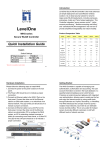

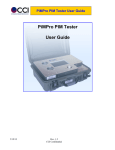


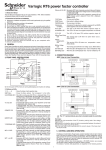
![Manual[DOWNLOAD]](http://vs1.manualzilla.com/store/data/005715994_1-2fafd5cf8faf458a6c3437b6894f1203-150x150.png)
